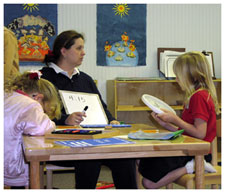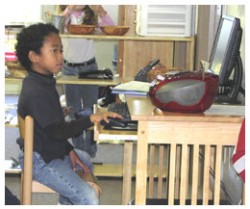Practical Life Skills
 One of the first goals is to develop in the very young child a strong and realistic sense of independence and self-reliance. Along with love and a stable environment, this is the child’s greatest need. This area of the curriculum focuses on developing skills that allow the child to effectively control and deal with the social and physical environment in which he lives.
One of the first goals is to develop in the very young child a strong and realistic sense of independence and self-reliance. Along with love and a stable environment, this is the child’s greatest need. This area of the curriculum focuses on developing skills that allow the child to effectively control and deal with the social and physical environment in which he lives.
There is a growing pride in being able to “do it for myself.” Practical life begins as soon as the young child enters the school and continues throughout the curriculum to more and more advanced tasks appropriate to the oldest students.
- Early Tasks (Age 3-5)
- Dressing oneself
- Learning home address and phone number
- Pouring liquids without spilling
- Carrying objects without dropping
- Carrying liquids without spilling
- Walking without knocking into furniture or people
- Using knives and scissors with good control
- Using simple carpentry tools
- Putting materials away on the shelves where they belong when finished
- Working carefully and neatly
- Dusting, polishing and washing just about anything: floors, tables, silver
- Sweeping and vacuuming floors and rugs
- Flower arranging
- Caring for plants and animals
- Table setting-serving yourself-table manners
- Folding cloth: napkins, towels, etc.
- Simple use of needle and thread
- Using common household tools: tweezers, tongs, eye-droppers, locks, scissors, knives
- Increasingly precise eye-hand coordination
- Simple cooking and food preparation
- Dish washing
- Weaving, bead stringing, etc.
 This process continues logically so that older students will learn such practical tasks as:
This process continues logically so that older students will learn such practical tasks as:
- Caring for animals
- Dog training
- Sewing
- Cooking complex meals
- Working with tools
- Making simple repairs
- Basic auto maintenance
- Getting around on their own: Metro, buses, cabs, hiking
- Self-defense
- Computing tax forms
- Making consumer purchase decisions, comparison shopping, budgeting
- Maintaining a checkbook
- Applying for a job
- Earning spending money
- Mastering test taking strategies
- Caring for young children
- Interior decorating
- Making clothes
- Furniture refinishing
- Wilderness survival
- Running a small business enterprise
- Gardening
Sensory Training
These are exercises in perception, observation, fine discrimination, and classification that play a major role in helping our children to develop their sense of logic and concentration. They begin at age 3 and are a major area of concentration typically through age 5.
- Discrimination of length, width, and height
- Discrimination of volume
- Discrimination in multiple dimensions
- Discrimination among color tones
- Discrimination among geometric shapes for shape and relative size
- Discrimination among solid geometric shapes by sight and touch
- Solving of complex abstract puzzles in three dimensions
- Discrimination of intensity and nature of sounds
- Discrimination among musical tones
- Discrimination of texture by touch
- Discrimination of weight by touch
- Discrimination of temperature by touch
- Discrimination of scents
Which, in the older students, lead to such skills as:
- Precise observation of the natural world
- Culinary discrimination
- Artistic appreciation
- Architectural appreciation
- Musical appreciation

